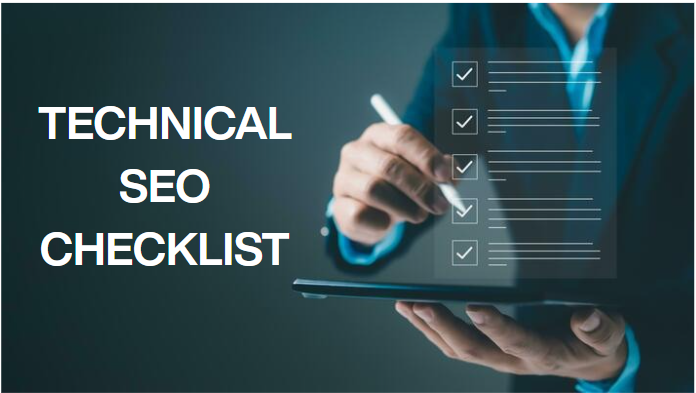Mar 06, 2025
Technical SEO Checklist for 2025: Everything You Need to Rank

In a world where search engines evolve faster than ever, Technical SEO remains the backbone of your site’s success. This isn't just a basic list — it's a powerful, step-by-step SEO blueprint for 2025 that helps Google understand, trust, and rank your website.
Whether you’re a beginner, blogger, marketer, or agency, this guide simplifies every important technical SEO element so you can implement with confidence — no jargon, just results.
What is Technical SEO & Why It’s Crucial in 2025?
Technical SEO is the process of optimizing your website's infrastructure so search engines can crawl, index, and understand your pages efficiently. It's not about keywords — it's about building a solid, fast, and structured digital foundation.
Why is it critical in 2025?
- Google’s algorithms now rely on semantic relationships and user behavior
- Sites must be fast, secure, mobile-first, and AI-readable
- Poor technical SEO = low rankings regardless of great content
1. Crawlability & Indexation
Craft a Clean Robots.txt File
- Located at yourdomain.com/robots.txt
- Block admin pages and internal search results
- Allow bots to access assets like JS and CSS for rendering
- Use "Disallow:" and "Allow:" carefully to avoid de-indexing valuable content
Submit an Accurate XML Sitemap
- Generate with Yoast SEO, Rank Math, or Screaming Frog
- List only index-worthy URLs — no drafts, duplicates, or redirects
- Submit it to Google Search Console and Bing Webmaster Tools
- Link it in your robots.txt for auto-discovery
Fix Crawl Errors in Google Search Console
- Go to Coverage report > Check ‘Errors’ & ‘Excluded’
- Resolve 404s, redirect loops, soft 404s, and server errors (5xx)
- Set proper status codes (200/301/410) as needed
Ensure All Important Pages Are Indexable
- Avoid accidental noindex tags
- Don’t overuse canonical tags pointing elsewhere
- Use meta robots, x-robots-tag headers, and canonical properly
2. Website Performance & Core Web Vitals
Optimize Largest Contentful Paint (LCP)
- Target load time: under 2.5 seconds
- Compress images with WebP/AVIF
- Use lazy loading for offscreen assets
- Defer third-party JavaScript
Reduce First Input Delay (FID)
- Goal: less than 100ms
- Optimize JavaScript execution
- Minimize third-party scripts (e.g., chat, analytics)
- Use efficient themes and frameworks
Eliminate Cumulative Layout Shift (CLS)
- Target: under 0.1
- Reserve space for ads and embedded content
- Set image/video dimensions in HTML or CSS
Test with PageSpeed Insights & Lighthouse
- Get real-user metrics (field data) from CrUX
- Resolve issues flagged under Performance, Accessibility, Best Practices
- Monitor Desktop & Mobile results separately
3. Website Security
HTTPS Is a Must (No Exceptions!)
- Use SSL certificates sitewide
- Redirect all HTTP to HTTPS with 301s
- Set HSTS headers for long-term HTTPS enforcement
Eliminate Mixed Content Warnings
- All resources (JS, CSS, images) must be loaded via HTTPS
- Update hardcoded internal and external URLs
Set HTTP Security Headers
- Enable Content Security Policy (CSP)
- Use X-Content-Type-Options, X-Frame-Options, Referrer-Policy
- Scan with SecurityHeaders.com to ensure compliance
4. Mobile Optimization
Build a Mobile-First, Responsive Design
- Use flexible layouts with media queries
- Avoid Flash, pop-ups, or horizontal scroll bars
Fix Issues in Mobile Usability Report
- Go to GSC > Mobile Usability
- Address font sizes, button spacing, viewport issues
Analyze Core Web Vitals for Mobile
- Mobile users are more sensitive to delays
- Optimize LCP, FID, CLS specifically for mobile experience
5. Site Architecture
Maintain a Flat, Logical Structure
- Ensure pages are 3 clicks or fewer from the homepage
- Avoid deep, isolated content
Use Descriptive, Clean URL Structures
- Use hyphens not underscores
- Avoid dynamic parameters where possible
- Example: /best-running-shoes instead of /category?id=123
Add Breadcrumb Navigation
- Enhance internal linking and crawl paths
- Mark up breadcrumbs with Schema.org
Implement Strategic Internal Linking
- Use anchor text with semantic value
- Link from high-authority pages to new content
- Create topical clusters with pillar and supporting pages
6. Structured Data & Schema Markup
Add Relevant Schema Types
- FAQPage, Product, LocalBusiness, Article, Review, HowTo
- Helps Google generate rich snippets
Test with Rich Results Tool
- Validate JSON-LD schemas here: https://search.google.com/test/rich-results
Use JSON-LD Format (Recommended by Google)
- Clean, flexible and easy to update
Monitor Schema Errors in GSC > Enhancements
- Fix any invalid fields or incorrect usage
7. Canonicalization & Duplicate Content
Use rel=canonical Intelligently
- Every page should self-canonical unless otherwise needed
- Avoid canonicalizing paginated pages to page 1 blindly
Handle URL Parameters & Duplicates
- Use GSC > URL Parameters to guide Google
- Avoid indexing multiple filtered or sorted versions of a product page
Implement hreflang for Multilingual/International Sites
- Prevent duplicate indexing across different regions
- Always pair each hreflang with a self-referencing tag
8. Crawl Budget Optimization
Clean Up Low-Value URLs
- Noindex or block: /tags/, /search/, /archives/
- Reduce duplicate URLs
Fix Redirect Chains & Loops
- Keep redirects to a single hop
- Audit regularly with Screaming Frog or Ahrefs
Fix & Redirect Broken Links
- Monitor weekly for 404s
- Redirect or update broken internal/external links
9. JavaScript SEO
Make JavaScript Content Discoverable
- Use server-side rendering (SSR) or dynamic rendering for bots
- Test with Fetch as Google or Mobile-Friendly Test tool
Pre-render or SSR Important Pages
- Especially for SPAs (Single Page Applications)
- Tools: Rendertron, Prerender.io, Next.js
Clean & Optimize JS Loading
- Bundle and compress scripts
- Remove unused JavaScript with Chrome DevTools coverage tab
10.Technical Monitoring & SEO Tools
Google Search Console: Your First Stop
- Check crawl stats, indexing, performance, manual actions
Run Full Audits with Screaming Frog or Sitebulb
- Identify thin content, duplicate titles, redirect loops, missing alt text
Set SEO Alerts with Visualping or ContentKing
- Alert for index drops, robots.txt edits, title/heading changes
Monitor Log Files
- Understand which URLs are crawled most often
- Use JetOctopus or Loggly
11 Technical SEO Mistakes to Avoid in 2025
- Using infinite scroll with no crawlable links
- Blocking JS/CSS needed for rendering
- Duplicate or missing meta titles/descriptions
- Indexing internal search pages
- Having orphan pages (no internal links)
12. What’s Changing in 2025
AI-Driven Indexing is Here
- Google’s systems rely on entity relationships and semantic context
- Use contextual linking, schema, and structured content clusters
UX & Design Affect Rankings
- Smooth user flow, no intrusive ads, accessible design
- Monitor scroll depth, click interactions, dwell time
Entity-Based Ranking Signals
- Define your content around who, what, where, how
- Reinforce entities across pages (brand, product, location)
Optimize for Voice & Visual Search
- Use conversational Q&A formats
- Add rich image alt text and descriptive file names
Final Words: Make Technical SEO Your Competitive Advantage
This detailed technical SEO checklist for 2025 is your roadmap to Google’s good graces. As the search landscape evolves, only technically sound websites will stay relevant, competitive, and indexed favorably.
That’s where Uprankx comes in. Their expert team helps you tackle technical SEO challenges head-on, ensuring your site is fully optimized, crawlable, and future-ready.
Start today — with Uprankx by your side, turn your website into a high-performing, Google-friendly powerhouse.




